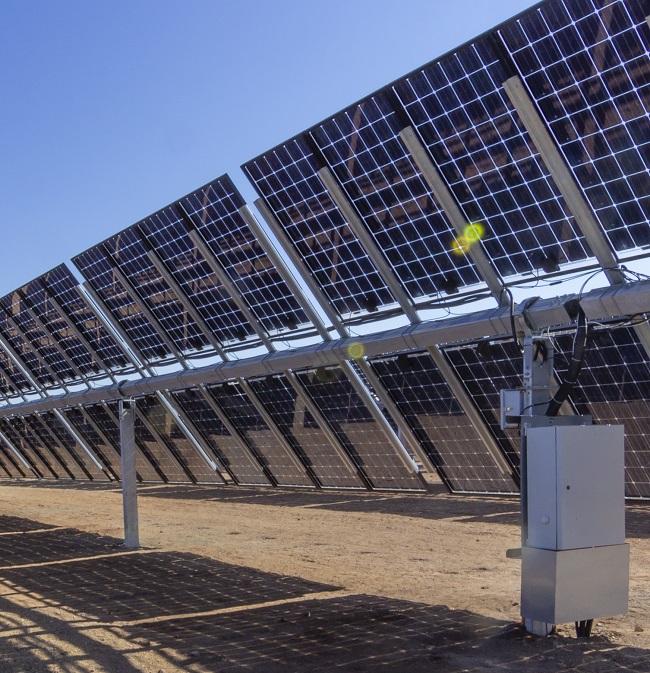Qatar expands bifacial PV tests as data shows 10% output gains
The Middle East state is building a commercial-scale bifacial testing facility and advancing soiling studies that will apply to many other desert regions.

Related Articles
Interest in bifacial solar plants is soaring and operators are seeking more comprehensive testing of performance drivers to optimize investment decisions.
Many U.S. PV operators are turning to bifacial plants to increase power yield amid growing market competition. A first wave of U.S. large-scale bifacial solar plants this year will provide valuable operational data and test the accuracy of laboratory modelling.
Bifacial systems are forecast to represent 10% of the U.S. utility-scale solar market in 2019, rising to 30% by 2025, according to the US National Renewable Energy Laboratory (NREL). By 2028, bifacial cells could represent 40% of the global solar market, the International Technology Roadmap for Photovoltaic (ITRP) said.
In the Middle East, the Qatar Environment and Energy Research Institute (QEERI) is advancing the testing of commercial bifacial technologies in dry and desert -like conditions, providing learnings that that can be applied in multiple global markets.
Part of Hamad bin Khalifa University, QEERI has tested bifacial PV modules at its outdoor test facility since 2016 and will soon provide data crucial to commercial deployment.
QEERI has built significant datasets on key metrics such as PV electrical performance and temperature, irradiation, ground reflectance (albedo) and metrological conditions. Current research includes the impact of soiling on the rear side of bifacial modules, an area where industry knowledge is limited.
Site tests have shown high ground reflectance and output gains for bifacial modules and QEERI is now building a horizontal single-axis tracker bifacial plant which will act as a commercial reference facility, Veronica Bermudez, Senior Research Director, Energy Center, QEERI, told New Energy Update.
"This will be at a scale large enough to be representative of a commercial facility - multiple rows and realistic module layout. The benefit of this project is allowing a real-world performance model of bifacial yield to be generated and calibrated for Qatar conditions," Bermudez said.
The findings could boost development in a host of PV markets as similar ground conditions can be found in other parts of the Arabian Peninsula and in other global desert environments, she noted.
High reflectance
Ground reflectance, known technically as albedo, is a critical performance driver for bifacial developers.
Materials like grass, dirt, wet dirt, dry sand and snow have vastly different reflectance properties and early commercial projects will pioneer ground treatment methods developed in research studies.
Effect of material on ground reflectance
(Single bifacial panel at height of 1m)

Source: NREL-led research paper: 'Assessment of Bifacial Photovoltaic Module Power Rating Methodologies—Inside and Out,' March 2017.
The ground conditions at QEERI's test facility consists of light-colored crushed rock on top of natural ground, typical conditions for Qatar.
The albedo is approximately 40% (0.4 as fraction), higher than most natural ground services aside from snow, Bermudez said.
"Compared to monofacial silicon PV modules at fixed tilt, bifacial modules produced around 10% more energy (annual average) in a reliable way," she said, noting this figure depends on plant design and specific module technology.
In the U.S., NREL is currently developing the first ever database of albedo values for different regions and different types of ground surface.
Data collected will include types of vegetation and soil, data from surface radiation, CO2, water and energy flux networks.
Rear-side soiling
In 2018, QEERI launched a Solar Consortium which brings together industry and state research partners. The consortium is currently working with industry partners to test the impact of soiling on the rear-side of bifacial modules, thus far an area of limited study.
While tests are ongoing, techno-economic analysis indicates that "even a small soiling rate in the rear side of bifacial modules, has a big impact on the final kWh/kW ratio," Bermudez said.
These studies will allow companies to find solutions that minimize production losses.
With margins under pressure, a growing number of operators are switching to advanced remote and automated cleaning mechanisms to reduce labor costs.
QEERI will soon launch a major study into the impact of the latest mechanical cleaning technologies on module performance.
"We are especially interested in PV coating abrasion caused by mechanical cleaning, and we are launching a large-scale field research project that later this year on this topic," Bermudez said.
QEERI is also conducting joint research with meteorological experts to understand soiling patterns and forecast the impact of soiling on plant performance.
"Our extensive data acquisition system gathers all essential PV electrical and temperature metrics, as well as irradiation and meteorological conditions," Bermudez said.
QEERI energy specialists are working with their environmental colleagues to identify soiling patterns and "forecast soiling behavior as we forecast solar resource," she said.
New Energy Update
